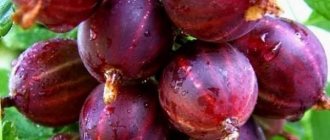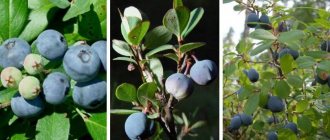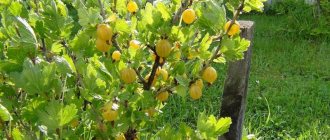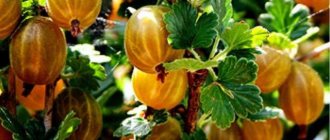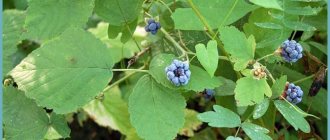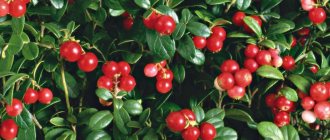Standard gooseberry
A standard tree is a completely different matter, and underneath it are even flowers or parsley.
The standard method of growing gooseberries allows you to get a small attractive tree instead of a bush, from which it is convenient to harvest.
The idea came from Europe; they, with their stiffness, began to make standard models like roses out of bushes. And indeed, standard gooseberries planted along the path look very nice. Such bushes will not spoil the background either.
Advantages of the standard form
In addition to aesthetic pleasure, standard gooseberries also have a number of other advantages:
- easy care, harvesting, pruning;
- the fruits are evenly illuminated and shaped sweeter;
- the bush takes up less space in the garden.
The photo shows a standard gooseberry at the age of eight years.
Flaws
- regular destruction of root shoots;
- dependence of the harvest, and indeed the whole plant, on one shoot;
- When selecting varieties, only winter-hardy ones are needed.
PROS AND CONS OF DIFFERENT FORMS OF GOOSEBERRY
Growing gooseberries in bush formation (with 20-25 branches of different ages) is well mastered in amateur and industrial berry growing and, if agrotechnical requirements are met, ensures early fruiting, longevity of plantings and consistently high yields. Along with these advantages, this formation has negative aspects: a high probability of contamination of berries on fallen branches (especially in varieties with a spreading crown), certain difficulties in caring for, pruning and harvesting, a tendency to increased disease and pest damage if the bush thickens.
An alternative to bush forming gooseberries is to grow them on a trellis and trunk. Trellis allow you to raise the fruiting zone above the ground, achieve uniform lighting and ventilation of the fruit wall, and as a result, earlier and more friendly ripening, and most importantly, increase the mass of berries and improve the phytosanitary condition of the plantings. Gooseberries on a trellis are formed into 1, 2 or 3 shoots, and with a sparse planting scheme their number can be increased to 4-5. This technology is widely used in the Czech Republic, Poland, Germany, France and other countries of the world. In recent years, it has become increasingly attractive for Russian gardeners, as it is one of the best ways to improve the quality of berries, primarily their size and color.
EVERYTHING YOU NEED FOR THIS ARTICLE IS HERE >>>
The method of growing a crop on a trunk (in the form of a miniature tree) is the least common in our country, but undoubtedly it deserves attention. It should be noted that gooseberries, along with red currants, are used to form plants on a trellis. Gooseberry plants are formed on a trellis more often than black currants. In a number of Western European countries, such plants are grown on an industrial scale, but they are most popular in home gardening. Let's talk in more detail about the pros and cons of this formation, which is still unusual for us.
Standard plants have many advantages. Thanks to the raised crown, the “berry tree” is easier to care for, prune and harvest, and the fruits are larger due to improved lighting conditions. Flowers and young ovaries of standard forms, in comparison with bush-shaped ones, suffer less from late spring frosts.
The stamps are very compact, therefore they are most suitable for small plots of land where there is a shortage of land area. In addition, they are quite decorative and can serve as an element of landscape design. Both single and group plantings look good; planting trunks in one line, for example along paths, is an excellent option.
There are also disadvantages - the need to regularly remove the root shoots of the rootstock, the dependence of the entire plant on the state of a single shoot (trunk), as well as an increased risk of winter damage. In this regard, it is advisable to grow in standard form varieties that have high winter hardiness of branches and flower buds, preferably large-fruited and having long-lasting branches and fruits.
Methods for obtaining a standard
To make a standard form of gooseberry, you need knowledge and experience, as well as a great desire, and the technique itself can be carried out in two ways:
- Stage-by-stage formation on a short or taller trunk.
- With the help of vaccination.
Forming step by step
For this method, gooseberries can be grown on their own roots.
Scheme of step-by-step pruning of gooseberries.
- When planting in a permanent place and completely rooting the bush, only one, but the strongest shoot is left, as a rule, the most upright . That is why, for the formation of standard gooseberries, varieties with straight-growing, dense, thick shoots are preferred.
- All shoots except one are cut out at ground level, and the top of the one left is shortened.
- Blinding is carried out on the abandoned shoot . This is a procedure for removing all the buds that are located from the bottom of the shoot, but leaving the top 4–5.
- In the first and second years of growth of this form, all shoots that develop from the remaining buds are shortened by half . You need to focus on the bud that looks up on the shoot.
- In subsequent years, the shoots are no longer shortened, but only partial pruning is carried out on those shoots that have bear fruit and have aged, as well as those that grow inward, or are braided, as well as those that are diseased or broken.
- Those growths that appear on the trunk and near it must be removed in a timely manner, preventing the plant from losing roots and nutrients.
Grafting method
- For grafting, golden currant seedlings are used and cuttings of cultivated gooseberries are grafted onto its trunk.
- Currant rootstock is grown independently from layering or cuttings, but forcing is carried out not by a bush, but by one vertical shoot.
Grafting gooseberries onto yoshta - the photo shows the growth in one season.
According to experienced gardeners, Yoshta (a hybrid of currants and gooseberries) serves as a very good rootstock . Its shoots are smooth, straight, strong, winter-hardy, and not affected by diseases and pests. Such a rootstock is also left with one shoot, and the side shoots that appear on it are not removed, but pinched, this contributes to the rapid thickening of the trunk itself.
Stem height
The height of a gooseberry trunk grafted onto gooseberries (a) and golden currants (b).
The principle for determining the height is as follows: if the rootstock is thin , then the height of the trunk is chosen to be about 120–130 cm. Such a trunk requires good, powerful support.
If the rootstock is strong , powerful, with a thick shoot that can itself hold a powerful “head”, then the grafting is done lower, to a height of 50 to 120 cm.
Vaccination times and methods
Methods for grafting standard gooseberries.
Each method has its own optimal time period.
- If the cutting is prepared in advance, then the grafting is done from the beginning of July, including the first days of September (if the temperature at night is not lower than 15 ᵒC). This can be done in a side cut.
- If the timing falls in late summer and early September, then it is better to do it with an oblique wedge or butt.
- In July-August - budding with an eye.
- The end of February is suitable for improved copulation (indoors only).
Standard gooseberry on currant rootstock, first year of fruiting.
Rules of care
Although gooseberries are considered a drought-resistant crop, regular abundant watering, especially during flowering, will ensure a good harvest of berries. The roots of standard gooseberries are located at great depths, so water should saturate the soil at least 40 cm deep. The rate of one-time watering under a tree is about 50 liters. The plant needs loosening of the soil and further mulching, after which a crust does not form on the surface, weeds do not multiply, and moisture is retained in the soil. Sawdust can be used as mulch. straw, mown grass, peat.
In the year of planting, fertilizers are applied to the planting hole. The next feeding is carried out in the second year of growth during the appearance of buds, then during flowering and the last one during the setting of berries. A mixture of nitrogen, potassium and phosphorus is used for this.
The standard gooseberry needs constant support in the form of a peg installed on the wind side. It is cleared of bark, treated with a special impregnation to prevent rotting, and painted. Important! The plant is tied in two places in a figure eight pattern - in the middle of the trunk and at the level of the crown, so that constrictions do not form.
Periodic pruning is necessary to obtain a beautiful and functional crown of standard gooseberries. During the first, they try to give it a rounded shape. After five years, pruning is carried out to rejuvenate the plant, removing old and diseased branches.
Important! Annual growth should be carefully monitored, shortening shoots that are too long.
It is very difficult to cover standard gooseberries for the winter. Experts advise carrying out the simplest measures before the winter cold - increasing the layer of mulch on the tree trunk, hilling and covering the trunk with spruce branches.
Storing rootstock for the trunk
In late autumn, the rootstock is dug up and buried in the basement in wet peat, fine sawdust or sand.
- Cuttings are also harvested in late autumn (before sub-zero temperatures) and stored under the same conditions. For ease of use, the spikes can be cut off.
- After vaccination, the entire “set” must be stored for about 2 weeks at a temperature of about 20 ᵒC. To do this, special boxes are prepared in advance and gooseberries are placed there, and then everything is covered with a 1:1 mixture of peat and sand.
- After standing and warming up, the boxes are transferred to the basement and kept until the moment when planting can be carried out.
- A month after planting in open ground, the grafting strap needs to be loosened, and after another 2 weeks, removed.
- When the scions reach a length of 10 cm, they are pinched. If the processes progress successfully, a ready-made standard plant will be formed by the fall of the same year.
When should vaccination be done?
The procedure for grafting gooseberries is carried out in summer, winter or spring. Grafting by cuttings onto previously prepared and sufficiently strengthened rootstock seedlings is carried out during the growing season:
- from July to mid-September - in a side cut;
- in the last weeks of summer - in the butt or with an oblique wedge;
- from July to August - budding with a peephole with a piece of wood.
Excellent results are achieved by vaccination in winter and spring, which is carried out in the last week of February - early March.
Features of landing and supports
From the nursery, the trunk is planted in a permanent place with a distance of 1 m, and 2 m between rows.
The standard gooseberry is tied to a support immediately upon planting.
- The support is installed simultaneously with planting. The support stake can also be made of wood, but in this case it must be cleared of bark and the lower part impregnated.
- The garter is placed in two or three places, in the crown and on the trunk. If the gooseberry yield is high, then to prevent the branches from breaking off, it is necessary to select a stake higher than the standard and spread the fixing bases from it in different directions.
- If several bushes are planted at the same time, then you can lead the garter to horizontal trellises.
The basis of a beautiful trunk shape is pruning
It is very convenient to trim standard bushes, and it is not difficult to make a beautiful spherical shape.
Formative pruning of standard gooseberries is done in early spring.
To get a sphere you need to try to grow 6 main shoots by the end of the second year. The central conductor is shortened by 1/8 of the increase, the remaining branches are cut shorter, giving the crown a rounded shape. With such pruning, rejuvenation begins only after 5–6 years. Old branches are removed gradually and so that symmetry is maintained. Those shoots that grow below the grafting site are regularly removed.
Standard gooseberry bushes are gaining more and more popularity in the south of the country, but for northern latitudes this is still problematic, even if work is carried out with winter-hardy varieties.
Shelter for the winter
When planning to grow a standard gooseberry, you need to think in advance about how exactly it will be covered for the winter. To do this, they equip special canopies or bend down to the ground, as they cover the standard rose .
Planting gooseberries on a trunk
Gooseberries love air, light and space. Therefore, it is planted in a sunny place, in moist and fertile soil with an acidity level of pH 6.0–6.8. A distance of at least 1 m is maintained between the bushes. Low-lying and swampy areas where water stagnates, and places with heavy chalky or sandy soil are not suitable for the crop.
The bush gets along well next to red currants and tomatoes. It is not recommended to plant the crop next to raspberries, black currants and wheatgrass, as they share common pests.
Favorable time for planting
Autumn is considered a favorable time for planting gooseberries on a trunk. The bush is planted in early spring, but there is a risk of its death, since during the summer heat the soil becomes dry and the roots do not have time to take root.
Landing rules
Step-by-step landing algorithm:
- The area is dug up, removing weeds and stones. Dig a planting hole. It should be 2 times larger than the roots of the plant. The excavated soil is mixed with rotted manure or compost in equal proportions.
- The roots of the plant are shortened slightly so that new young roots are formed at the cutting point. It is advisable to dip them in a solution of a root formation stimulator.
- The branches that thicken the trunk are cut off, the rest are shortened. The top of the gooseberry is not touched.
- A support system (stake or metal profile) is dug into the planting hole, a seedling is placed in the center, and the roots are straightened. Cover everything with soil mixture and compact it.
- The plant is well watered and the soil is covered with mulch.
- Gooseberries are tied to a support system in the middle of the trunk and crown.
To increase the yield, quality and taste of berries, it is recommended to plant several varieties on the site.
conclusions
The berries are ripening on standard gooseberries.
Recently, the demand for standard forms has been increasing , and nurseries are starting to grow seedlings specifically for such purposes. Such “bushes” come out fully formed, with a closed root system, and the price, compared to bush forms, is not much higher.
When planning to grow standard gooseberries, think about what the rootstock and scion will be like, where to get it, how to grow it, and how to preserve it, take into account the fact that you won’t get berries for the first 3-4 years , but in 5-6 years you will get very few . Evaluating all the pros and cons, decide whether you need a standard gooseberry in the garden, or limit yourself to ordinary bushes, but expect a good harvest of tasty berries.
Popular varieties for standard
The varietal characteristics of the crop play a major role in growing gooseberries on a trunk. Varieties that do not grow widely and produce few basal shoots are better suited for this purpose. The list of the most suitable varieties for the standard can be found below.
Invicta
Invicta is a popular gooseberry variety that produces high yields. The berries are aromatic, juicy, and can reach a weight of 8 g. The bushes are vigorous and require regular pruning.
"Invicta" is distinguished by its early ripening period
Kolobok
The fruits of the Kolobok gooseberry are large – up to 7 g, dense, and have a pleasant aroma. Bushes with a small number of thorns on shoots located at a far distance from each other. The height of the crop grows up to 150 cm.
The high-yielding gooseberry variety “Kolobok” has an average ripening period
Krasnoslavyansky
Bushes of the Krasnoslavyanskiy variety are compact, with good fruiting. A plant over four years old can produce up to 6 kg of berries per season. The fruits have a dessert taste and are dark red in color.
The “Krasnoslavyansky” variety tolerates temperatures down to – 40 degrees
Red Triumph
The fruits of the gooseberry "Red Triumph" (Rubrum Triumphum) are distinguished by high taste. The bushes of this variety are powerful and not spreading. The pulp of the berries has a slight sourness.
The Red Triumph bush can bear fruit for 40 years
Redball
A distinctive feature of the Redbol gooseberry is the absence of thorns. Thanks to their dense peel, the berries are well stored and can withstand transportation well. The taste of the fruit is sweet and sour.
"Redball" is considered the most popular variety of thornless red gooseberry
Pink 2
The mid-early gooseberry variety “Pink 2” (Rozoviy 2) is distinguished by abundant fruiting and good winter hardiness. Has good resistance to disease. The berries are large - up to 6 g, red-pink in color.
“Pink 2” tolerates frost well and is suitable for central Russia
Russian
Gooseberry "Russkiy" (Russkiy) belongs to the mid-late varieties. It tolerates frost and drought perfectly and has strong immunity. The variety can be grown throughout Russia, except the Urals.
Gooseberries of the "Russian" variety can be grown in arid regions
Firework
"Salyut" begins to bear the first harvest in July. The crop's resistance to frost is average and to disease - high. It bears fruit with large cherry-colored berries that have a dessert taste.
Gooseberry berries "Salut" are universal in use
Seedling Lefora
Gooseberry “Seyanec Lefora” is a mid-early variety. The shoots of the plant have a small number of thorns. The bushes are resistant to diseases and frosts and produce a good harvest.
Due to the few thorns, “Lefort Seedling” is convenient to collect
Ural grapes
Gooseberries “Ural grapes” (Uralskiy Vinograd) are ideal for growing on a trunk. The bushes are tall and form straight powerful shoots. Fruiting begins in mid-summer, green berries weighing 4-5 g.
“Ural grapes” is an early-ripening gooseberry variety with large berries
Date fruit
Gooseberries of the “Date” variety are distinguished by large berries and cope well with adverse weather conditions. Bushes with low shoot-forming ability. The branches are thick, medium-thorny.
Date berries can reach a weight of 20 g
Generous
The spreading, medium-growing gooseberry “Generous” bears fruit with medium-sized red-violet berries. The skin of the fruit is covered with a hairy coating and veins. The variety is suitable for canning; the berries have a sweet and sour taste.
The fruits of the “Shchedry” variety ripen closer to mid-August
Amber
The tall, early-ripening variety “Yantarnyj” grows widely, growing to a height of more than one and a half meters. The berries are yellow with an orange tint, sour, with a honey flavor. The variety is distinguished by long-term fruiting.
Gooseberry “Amber” is an undemanding, unpretentious and very productive variety
Diseases and pests
| Anthracnose Control measures:
| |
| Rust Control measures:
| |
| Aphid Control measures:
| |
| Sawfly caterpillars, moths, moths Control measures:
|
Reviews from gardeners
natasha
I grow standard gooseberries and black currants, I REALLY like them, they are easy to pick, look neat, and to be honest, we collect the same amount of product from them as from ordinary bushes.
Source: dacha.wcb.ru
zoya_aa _
I have a standard gooseberry growing, but it’s too early to draw conclusions, the standard gooseberry is in its 3rd year, it’s really convenient to pick, it takes up a lot of space, a lot of horizontal branches.
Source: www.sadiba.com.ua
How to pick blueberries with a combine harvester
In order to properly clean wild bushes, you need to familiarize yourself with the main points: is there a ban on the use of special devices, is there liability for their use.
Is it possible to harvest blueberries with a combine?
It is prohibited to use a blueberry scraper or other suitable device in the territory of the former Soviet Union. Since these devices severely damage the bushes and their branches, and they require a long period to fully recover.
Modern designs have a more gentle operating mode and do not injure wild bushes. They are officially allowed in Sweden and Finland. Norwegians also actively use them.
What are the responsibilities for using combine harvesters?
In Ukraine and Belarus, administrative liability is provided for the use of homemade berry pickers. The fine for non-compliance of a device with the law is almost 1900 UAH in Ukraine, 420 rubles in Belarus, 4000 rubles in Russia. The fruit picker is allowed if it meets certain requirements - there must be a distance of 5 mm between the teeth.
How to care for culture
The Hinnomaki variety is quite easy to care for. Growing such gooseberries is not difficult even for summer residents who have no experience in gardening. To make a plant happy with berries, you need:
- Form bushes in time.
- Apply fertilizers.
- Conduct disease prevention.
The shrub bears fruit for a long time. The variety produces a stable harvest, but in regions where frosts exceed 30 °C, it is recommended to insulate the plant for the winter.
Watering
Gooseberries can withstand drought normally, but when it lasts for a long time, the bush requires irrigation. However, excess moisture in the soil should not be allowed, as this can lead to root rot. Water the plant when the ovary is set, the fruits ripen and in the fall in preparation for winter. It is not recommended to irrigate gooseberries with a hose; it is better to dig a hollow and supply water into it.
Fertilizers
If, during planting, the holes were filled with humus and mineral complexes, the gooseberries can be fed only after a year. The variety needs a lot of potassium. In the fall, it is recommended to add:
- compost - half a bucket;
- superphosphate - 2 tablespoons;
- wood ash - 0.5 cups.
During flowering and fruit growth, organic matter is used. Every year the bush is fertilized with ammonium nitrate. After watering, rain and fertilizing, the soil under the plant is loosened, since the earth is covered with a crust and does not allow air to pass to the roots.
Formation
One of the conditions necessary to obtain a harvest of large berries is regular and proper pruning of gooseberries. In the spring, until the buds open, or in the fall, 1.5–2 months before the onset of frost, branches 5–6 years old that bear little fruit are shortened to stumps or removed completely.
Every year, up to 5 shoots are left from new root growths, which are evenly spaced, all others are cut out. Be sure to get rid of diseased and damaged gooseberry stems.
Harvesting and transportation
Gooseberries must be collected carefully so as not to be injured by the thorns . The easiest way to do this is to hold the branch with one hand, wearing a strong glove, and pick the berries with the other hand. Gooseberries are one of the few types of berries that are usually picked unripe for further culinary processing.
It can be collected from the beginning of summer in 2 stages: first, there will be early, insufficiently ripe berries for culinary preparation (in pies, sauces, jam), and then - sweet and more ripe fruits for fresh consumption. The berries that remain after the first picking will have a chance to grow, ripen and develop flavor - pick them when they are ripe and fully colored, and refrigerate immediately.
Gooseberries are best consumed immediately after picking, but they can be stored in plastic bags in the refrigerator for up to 7-14 days, depending on the degree of ripeness, without loss of taste. The berries withstand freezing well and are stored in the freezer until the next harvest.
Did you know? The value of culture was noted in his book “The Anatomy of Dessert” (1934) by Edward Banyard. He wrote that gooseberries are, of course, a berry, but they have an “ambulance” effect.
Thanks to its dense pulp and durable skin, unripe gooseberries can withstand transportation over long distances. Ripe berries are transported in small baskets (up to 2 liters).
Plant gooseberries on your site in the form of a standard crop - and you will be satisfied with the yield and decorativeness of such a plant. This is a fairly reliable and fruitful berry plant for the garden, with enormous health benefits.
